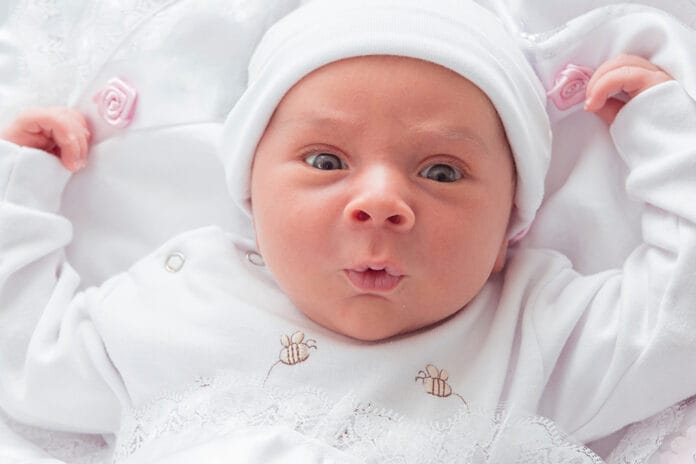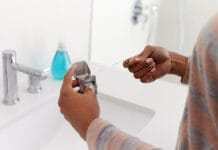Leave it to a TikTok member to share with the masses (2.7 million views) that babies can be born with teeth. The photo of the baby shook up many folks, but I would assume that was the point. When a baby is born with teeth, they are called natal teeth. Other terms we may have learned in school were congenital teeth, aberrant nodules, fetal teeth, precocious dentition (seriously?), dens cannatalis, and predeciduous.
This isn’t to be confused with neonatal teeth that come in during the first month of life. Natal teeth occur more commonly than neonatal teeth, with a ratio of 3:1.2
Folklore of Natal Teeth
While some believed that affected children were exceptionally favored by fate, some had the belief that they were ill-fated. In England, infants born with natal teeth were considered destined to be famous soldiers. Those born in France and Italy were considered future conquerors of the world.1 In Poland, India, and Africa, affected children were considered monsters and bearers of misfortune, and in China, it was considered a bad omen for girls.2 A few notable natal teeth recipients are Napoleon Bonaparte, Louis XIV, and Ivan the Terrible.3
Occurrence and Frequency
The incidence of natal teeth ranges from 1:2,000 to 1:3,500 live births, which seems like a lot to me. I honestly don’t recall hardly any in my 30-plus-year career.
Bohn’s nodules may be confused with natal teeth. Bohn’s are usually multiple and found along the buccal and lingual aspects of the lower and upper ridges. They are firm, whitish, asymptomatic, and shed within several weeks.
Natal teeth are rare in preterm infants and are more common among infants in some American Indian tribes. Most commonly, the teeth are found in the mandibular central incisor area, followed by maxillary incisors. Some research shows occurrence is more often for girls than boys.4 However, according to Stamfelj et al., the existence of natal teeth appears to be related to an accelerated or premature pattern of dental development rather than to the superficial positioning of the tooth germs.5
Etiology
Natal teeth are not often related to a medical condition, but sometimes they may be associated with Ellis-van Creveld syndrome, Hallermann-Streiff syndrome, Pierre-Robin syndrome, or Sotos syndrome. The causal hypotheses are sweeping, ranging from an inheritance as a dominant, autosomal trait, endocrine disturbances, congenital syphilis, febrile episodes during pregnancy, poor maternal health, or increased resorption of overlying bone.5 Environmental factors could play a role.
Examples of environmental examples include polychlorinated biphenyls (PCBs), polychlorinated dibenzo P dioxins (PCDDs), and dibenzofuran (PCDFs), which may cross the placenta, have been implicated.5,6 PCDDs and PCDFs are a group of environmentally-persistent contaminants that are released from the combustion of plastics and chlorinated waste from places like recycling plants or backyard barrel burning. PCBs were commercially manufactured from 1929 until 1979 when it was banned. Although not commercially produced in the U.S., products such as floor finish, oil-based paints, and fluorescent light ballasts may contain them.
Classification
In 1966, Spouge and Feasby classified natal and neonatal teeth on the basis of development, but in 1997, Hebling et al. classified them according to the appearance of the natal tooth in the oral cavity.7-9
Four categories based on appearance7,8
- Shell-shaped crown poorly fixed to the alveolus by the gingival tissue and absence of a root.
- Solid crown poorly fixed to the alveolus by the gingival tissue and little or no root.
- Eruption of the incisal margin of the crown through the gingival tissues.
- Edema of the gingival tissue with an unerupted but palpable tooth.
Maturity classification9
- Mature neonatal or natal tooth is one that is nearly or fully developed and has a good prognosis of maturity.
- Immature implies a tooth with incomplete or substandard structure having a poor prognosis.
If the degree of mobility is more than 2mm, the natal teeth of category 1 or 2 need extraction.
Only 1% to 10% of natal and neonatal teeth are supernumerary and should be extracted. Before any treatment, though, clinicians need to do a thorough clinical and radiographic exam for a definitive diagnosis.2 A radiograph is necessary to differentiate the primary deciduous tooth from a supernumerary tooth.
Worries
Complications, as you might imagine, would be discomfort during breastfeeding and aspiration of the teeth. No treatment is necessary if there are no problems with feeding or the teeth are not excessively mobile.
Another complication from natal and neonatal teeth is ulceration on the ventral surface of the tongue caused by the tooth’s sharp incisal edge. Downstream consequences seen with the teeth include carious lesions, pulp polyps, or premature eruption of successor teeth.
This is yet another area that has slipped my mind since my 1980s dental hygiene education. What may be a benefit is teaching nurses who work in obstetrics the 411 of natal teeth, but perhaps they already know. This is an area where dental professionals in the hospital setting would work wonderfully.
As a dental professional, if you come across natal teeth, the best course of action is early assessment, including taking a radiograph immediately. If extraction is necessary, it should be done quickly so feeding is simpler and the risk of aspiration is mitigated.
Before you leave, check out the Today’s RDH self-study CE courses. All courses are peer-reviewed and non-sponsored to focus solely on high-quality education. Click here now.
Listen to the Today’s RDH Dental Hygiene Podcast Below:
References
- Cunha, R.F., Boer, F.A., Torriani, D.D., Frossard, W.T. Natal and Neonatal Teeth: Review of the Literature. Pediatr Dent. 2001; 23(2): 158-162. https://pubmed.ncbi.nlm.nih.gov/11340731/
- Mhaske, S., Yuwanati, M.B., Mhaske, A. et al. Natal and Neonatal Teeth: An Overview of the Literature. ISRN Pediatr. 2013; 2013: 956269. https://pubmed.ncbi.nlm.nih.gov/24024038/
- Berkovitz, B.K.B. (2012). Nothing but the Tooth: A Dental Odyssey. Elsevier. ISBN 9780123971937.
- Anegundi, R.T., Sudha, R., Kaveri, H., Sadanand, K. Natal and Neonatal Teeth: A Report of Four Cases. J Indian Soc Pedod Prev Dent. 2002; 20(3): 86-92. https://pubmed.ncbi.nlm.nih.gov/12435004/
- Stamfelj, I., Jan, J., Cvetko, E., Gaspersic, D. Size, Ultrastructure, and Microhardness of Natal Teeth with Agenesis of Permanent Successors. Ann Anat. 2010; 192(4): 220-226. DOI: 10.1016/j.aanat.2010.05.003. https://pubmed.ncbi.nlm.nih.gov/20591639/
- McDonald, R.E., Avery, D.R., Dean, J.A. (2004). Dentistry for the Child and Adolescent (8th ed.). Mosby.
- Spouge, J.D., Feasby, W.H. Erupted Teeth in the Newborn. Oral Surgery, Oral Medicine, Oral Pathology. 1966; 22(2): 198-208. https://www.sciencedirect.com/science/article/abs/pii/0030422066902817
- Hebling, J., Zuanon, A.C.C., Vianna, D.R. Dente Natal – A Case of Natal Teeth. Odontol Clín. 1997; 7(1): 37-40.
- Rao, R.S., Mathad, S.V. Natal Teeth: Case Report and Review of Literature. J Oral Maxillofac Pathol. 2009; 13(1): 41-46. https://www.jomfp.in/text.asp?2009/13/1/41/44574












